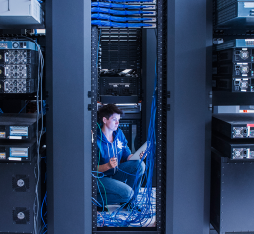“The role of network engineer is sure to evolve in the coming years, to focus increasingly on data science.”
Network coverage, voice quality, dropped-call rates, data speeds: quality of service (QoS) indicators are as diverse as they are accurate in order to provide an acute picture of customer experience levels. Poor quality of service is synonymous with ‘customer churn,’ where customers simply jump ship and move to the competition. As a result, all carriers are pouncing on this crucial topic. The rise of AI could lead to greater differentiation among the competition. “Carriers who can use AI most effectively to operate their mobile network will undoubtedly have an advantage over their competitors,” says Paul-Michel Bognier, Head of Network Performance at Sofrecom.
Measuring QoS
Tools for collecting, measuring and analyzing data on quality of service are deployed at several levels, starting with network equipment, which has always been carefully monitored. This purely technical view, which does not necessarily reflect customer experience, is supplemented by other means. Network performance is assessed in a way that mirrors mobile network ‘drive tests’ typically run by independent bodies like ARCEP (Autorité de Régulation des Communications Électroniques et des Postes — France’s electronic communications, postal and print media distribution regulatory authority). Smartphones are put in vehicles, which travel along roads and through cities. These phones are connected to networks operated by different carriers and have software on them that simulates human activity: starting a phone call, opening a web page and so on. The data from these real-world scenarios gives an accurate picture of the network’s status.” Carriers also use other methods, such as collecting technical data from users’ smartphones or installing probes at critical points on the network to collect large amounts of data.
Data and AI: The Pair to Watch
With 4G, new types of tools, such as ‘Self-Organizing Networks’ (SONs), began to emerge. These introduced self-configuration, self-management and self-optimization for mobile network equipment. “This technology is constantly maturing, and its new generation (NG SON), designed for 5G, is notably based on machine learning. Developments in this field illustrate the full potential of AI for quality of service on networks.” Paul-Michel Bognier cites several possible areas of application for AI: improving customer experience, predictive management for ‘customer churn,’ monitoring and managing network/IT operations, reducing fraud, etc. It would be impossible to predict all future use cases, but we can imagine tools capable of accurately predicting a QoS problem in an area or even tools that can automatically reconfigure the network before problems occur.
Maintaining an Operational Vision
As of yet, this field is largely unexplored and, in order for it to fully mature, even more technical data will need to be collected. “Processing this data and finding relevant uses for it will mean that the role of network engineer is sure to evolve in the coming years, to focus increasingly on data science. The main challenge in applying AI to QoS is to balance operational advantages with development time and investment. Keeping the bigger picture in mind, I am sure that there will be many opportunities for predictive analytics and data use.” In the meantime, Orange and its subsidiaries are stepping up research efforts to provide proof of concept for implementing new tools to optimize the customer experience of tomorrow.











